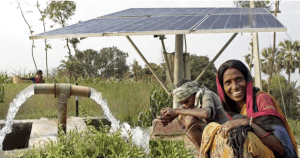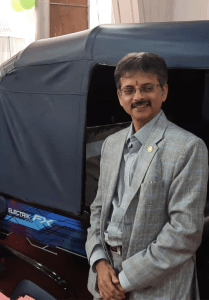By Rtn. Jaideep Malaviya, ESRAG South Asia Lead for Renewable Energy
The agriculture sector employs about half of India’s population, providing the primary source of livelihood for close to 60% of our people. India holds the record for the second-largest area of agricultural land of any nation in the world. Farming here primarily relies on ground-fed water, with external energy needed to operate pumps. At present, over 30 million agricultural pumps are installed in India, nearly 8 million of them diesel-powered. The total annual diesel consumption of these pumps works out to 5.52 billion liters, with associated emissions of 15.4 million tonnes of CO2. A quarter to a half million pump sets are added annually.
The Indian Government plans to place 3.5 million solar-powered water pumps to reduce carbon emissions and the country’s reliance on expensive fossil fuel imports. The plan includes generous government subsidies, and banks are willing to lend to farmers, but the need to come up with a downpayment is still a hurdle for many. Rotarians have a revolutionary opportunity to advance climate solutions and economic development by helping farmers close the gap.

Solar-powered water pump. Photo by Jaideep Malaviya
Coal is the primary source of fuel for electricity generation in India. As electricity becomes pricey owing to rising fuel prices, solar energy seems to be the ideal solution to meet the energy needs for agricultural pumping. The government of India currently subsidizes farmers’ electric use. Adding solar generation will reduce the government’s operating costs on these subsidies. The strategy the government is adopting is called “AGRIVOLTAICS,” – a combination of AGRIculture and power generation through solar PhotoVOLTAICS (PV) cells.
India has launched an ambitious programme of solarising agricultural pump sets. The goal is to place 3.5 million pumps with 10,000 MW grid-connected solar-powered feeder plants. When implemented fully, the plan will reduce annual diesel consumption by 1.38 billion litres, thus reducing India’s costs for importing petroleum products. The programme will abate carbon emissions by as much as 32 million tonnes per annum and generate an estimated 25 job-years per MW. The co-location of solar panels and commercial crops appears to be a feasible solution in the Indian context.
Croplands, grasslands, and wetlands are the top three land classes for AgriVoltaics. By shading crops, solar PV panels can help farmers produce to two or three times more fruit and vegetables – such as peppers, lettuce, pasture grass, jalapenos and cherry tomato plants – compared tp conventional agriculture setups.
A case study of the decentralised AgriVoltaic strategy is successfully operating in Dhundi, a village in the western Indian state of Gujarat. The village has been suffering a deteriorating water table caused by the fact that farmers have access to virtually free electricity and seldom switch off their electric pump-sets. To address this issue and also encourage use of sustainable energy, the State-owned electric utility came up with the idea of using Solar Photovoltaic (PV)-based pumps as an alternative to grid-based fossil fuel electricity.
The federal government was already offering a 30% subsidy. To help meet the high capital one-time investment, the state government of Gujarat extended an additional 30% subsidy. The electric utility worked out an agreement with a bank to loan farmers of a further 30% of the project cost. Thus the farmers had to only put in 10% equity to get 25 years of free electricity – the useful life of the solar panels.
The farmers’ panels connect to the grid. To further fascinate the farmers, the utility offered to buy back any additional power that they don’t use. This incentivized farmers to use electricity only when they need water, and export as much as possible to the grid to maximize their income. The additional income helps farmers repay the loan to the bank and also ensures the farmers only pump as much water as they need, helping to maintain the water table.
In the pilot project, nine farmers adopted 5 HP solar-powered pumps. With an agreement that the utility would buy their excess electricity, the farmers earned “Climate Smart” income of close to 5.5 lakh per year, wasted less groundwater, and reduced their CO2 emissions by 1,300 tonnes.
The success of this particular pilot project has prompted the Federal government of India to announce a national programme called KUSUM. The scalability is already demonstrated, with 0.19 million solar pumps installed and close to 1 million approved.
It is here the Rotary Clubs in India have an opportunity to adopt a cluster of farmers. One major bottleneck is the high capital cost of investment that farmers have to bear. Banks and financial institutions are ready to lend at subsidised interest rates, but require security. This is where Rotarians can help, by providing the upfront capital outlay that the farmer needs to provide, normally 10% of the cost of the solar-powered pump. Rotary International can showcase this as a global case of sustainable farming that mitigates climate change.
Typically the capacity of the feeder solar plants can range from 75 kWp to 300 kWp serving between 10 – 50 farmers calling for investment between US$ 50,000 to US$ 160,000. To begin, each Rotary International District can adopt anywhere between 20 to 100 farmers annually and gradually increase the target.
AgriVoltaic projects advance multiple Rotary goals at the same time: enhancing food security, conserving water, increasing energy justice, independence and reliability, and mitigating climate change. It is scalable and can result in immense positive impacts. Besides being a sustainable farming practice, it also reduces the pressure for urban migration by enhancing rural income opportunities and quality of life. The new solar generation will reduce peak demand on utilities, thus reducing the pressure to build new power plants.

Rtn. Jaideep at the RC Ullwe Node’s dedication of a new e-auto rickshaw they provided to a young taxi driver in 2022.
Rtn. Jaideep Malaviya (D 3131) serves on the Board of the International Solar Energy Society and consults with the Indian Government on an array of solar energy projects. In this picture, he’s demonstrating an electric auto-rickshaw. This is another sustainability opportunity he’s pitching to Indian Rotarians: helping low-income drivers make the switch to electric instead of diesel-powered vehicles. This cuts drivers’ operating expenses up to 80%, and eliminates their vehicles’ particulate emissions, which are so dangerous to the community’s health. As more solar charging stations come online, this will further reduce the country’s burden of air pollution by lowering demand on coal-fired plants. India has almost 2 million passenger auto-rickshaws approved by Regional Transport Offices.
